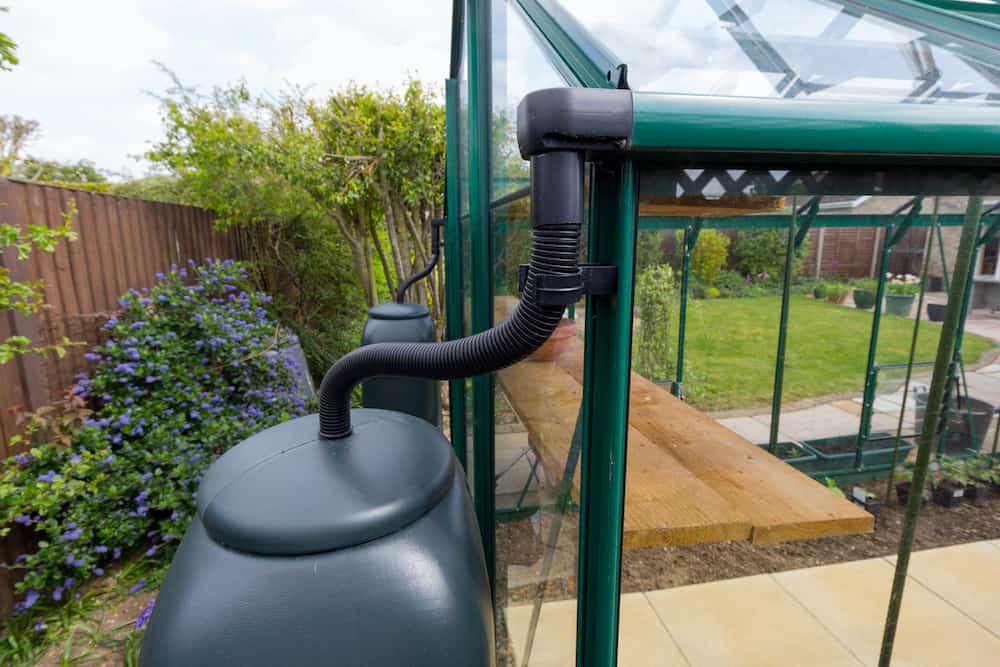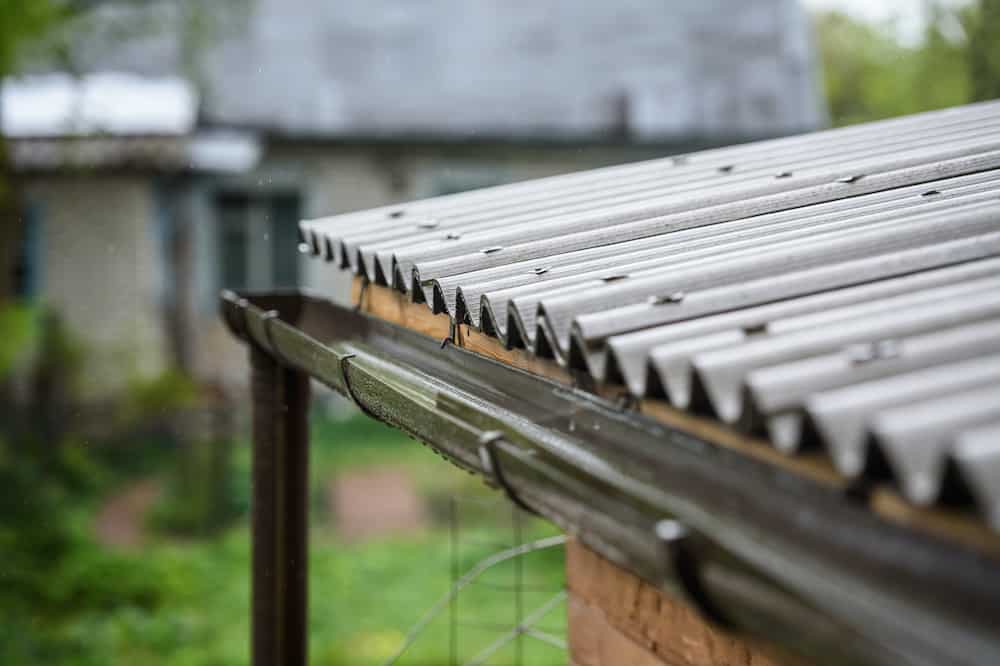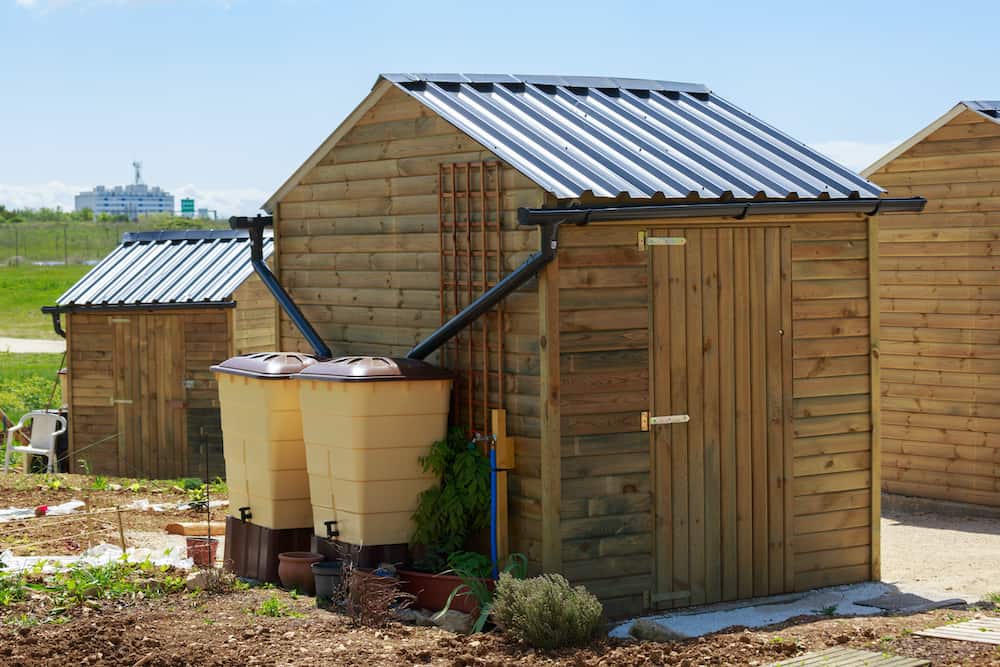Rainwater collection is a way for homeowners to lessen their environmental impact when it comes to maintaining their property. A variety of systems are available, from the simple approach of collecting rainwater in a barrel to more complex setups involving underground storage tanks, filtration systems, and automated irrigation systems.
Rainwater collection provides a sustainable source for watering gardens, drinking water for chickens and livestock, washing cars, and replenishing ponds. It reduces the demand on municipal water systems. By using collected rainwater for some things, homeowners conserve treated water for essential uses like drinking and bathing.
Installing a rainwater cistern was one of the best things I did on my property. It serves as an emergency water supply and is useful for many things we do.
Here, I explain the pros and cons of rainwater collection. Learn how you can make your at-home system, as well as essential tips to help you get the most out of the water you accrue.

What Are the Benefits of Collecting Rain?
Once you have checked your local bylaws and guidelines to determine the regulations (if any) about rain water harvesting, it’s essential to consider the benefits of this type of water collection.
Not only does it help to take the pressure off of municipal water systems, but it can also benefit your property in several ways.
Cost-Effective
By far, the most notable benefit of rainwater collection is that it is entirely free, apart from the equipment you’ll need to collect it safely.
Households can reduce their utility bills significantly, especially if you tend to use your regular lines to manage your property, such as watering gardens or maintaining livestock.
With the addition of potential incentives and rebates, you have even more of an opportunity to save on your monthly bills.
Establishes Self-Sufficiency
If you have always been interested in building a self-sufficient household, one of the first things you should do is install a rainwater collection system.
However, you will want to ensure there aren’t any laws preventing you from using the water for potable uses.
Otherwise, you will still have to rely on city resources.
Not only will you be able to establish your self-sufficiency, but you can also become more environmentally responsible by helping to conserve water.
Easy to Maintain
Most of the resources you will need to make your rainwater system are readily available and incredibly inexpensive, which is why it is such a desirable project.
Also, over time, the equipment that you invest in will be simple to maintain, especially if you have a system that is designed by a licensed and professional engineer.
The simple technologies within any collection system will be easy for the everyday homeowner to keep up with instead of having to call a plumber for water-related issues.
Easily Retrofitted
There’s no need to worry about adding a water collection system to your property, unless you live in a state where the unit will need to be built into your existing home, such as Texas.
These devices are incredibly easy to retrofit or to add to new developments, allowing you to take advantage of collecting rain at any stage of your property ownership.
Ideal for Emergencies
You never know when you won’t have access to regular running water, which is why most households rely on rainwater collection.
In an emergency, you will have multiple gallons of water available for you to use for potable and non-potable purposes, depending on where you live.
This gives plenty of homeowners the peace of mind they need to ensure they will always have access to one of the essential forms of sustenance.
How to Make a Rainwater Collection System
Learning how to collect rainwater is much easier than some may think, especially as you might not need to invest in expensive equipment or acquire the help of a professional engineer.
Using a few items that you might already have around the house, you can begin your system.
Alternatively, you can buy a few inexpensive items from your local hardware store to start the process, as well.
There are several different types of DIY rain collection systems you can make within a matter of minutes to have a more environment-conscious household.
Manufactured Rain Barrel Systems
By far, the most popular type of at-home rainwater collection system is to take advantage of rainwater barrels.
These are specially designed products that are placed outdoors and manage your rainwater. The materials used to create the barrels are typically wood, metal, ceramic, plastic, or stone.
Your choice would depend on your price point and whether you want them to add to the aesthetics of your property.
You can find barrels that emulate plant pots or others that have a more industrial design, similar to what you would expect from plastic rain barrels.
If you decide to purchase a manufactured rainwater barrel, it will come with everything that you need to begin collecting rain.
This includes water drainage, mesh screens, spigots, and special openings that are pet- and child-safe.
Depending on your budget, it can be preferable to opt for a manufactured product, as it’s an all-in-one solution that simply needs to be assembled.
The most cost-effective option, however, is to build your own.
DIY Rain Barrel Systems
For this project, you will need two rubber and two metal washers, one tube of watertight sealant, a large plastic garbage can, one hose clamp, a drill, one spigot, a utility knife, and landscaping fabric.
Step 1: Drill and Insert the Spigot
First, you will need to use your drill to make a hole towards the bottom of the garbage can, as this is where the spigot will be inserted.
It’s best to use a drill bit that is one size smaller than the width of the spigot or one that is of equal size.
Otherwise, there will be too much space to be adequately filled with your sealant.
Once the hole has been drilled, you can then insert the spigot into the hole, placing the metal washer on the threaded end and fitting the rubber washer over half of the threads.
Step 2: Seal the Spigot
To help prevent water from leaking out of your rainwater barrel, you will want to apply the waterproof sealant over the rubber washer, quickly inserting the spigot into the hole.
Wait for the sealant to dry before adding a rubber and metal washer to the remaining half of the threads on the inside.
It’s also a good idea to take an extra step to secure the spigot using your hose clamp.
This will provide additional protection against the faucet falling out of the barrel.
Step 3: Create Entry and Exit Holes
The next step of the DIY is to create the holes responsible for catching the water, which is where your utility knife will come into play.
Using the knife, cut a hole in the lid of the garbage can, making sure the hole is big enough to accommodate the size of the downspout from your house.
Your drill should also be used to make two additional holes on the top of the barrel, which can help to manage any overflowing water during severe storms.
Depending on how much water you are legally allowed to collect, you can even consider connecting a second barrel or garbage can to the original fixture.
All you need to do is use a PVC pipe or hose to connect the overflow pipe from one barrel to the entry hole in the second barrel.
This will also allow you to take advantage of excess water.
Step 4: Create a Top Seal
Maintaining the safety of your collected water is of the utmost importance, especially if you intend to use it for potable purposes.
Taking your landscaping fabric, cut a piece that is large enough to cover the entire surface of the can and then some.
Pull it tight across the circumference of the barrel or garbage can.
This fabric is essential for blocking leaves and debris as well as insects, such as mosquitoes, from entering the barrel.
When you have sufficiently sealed the open container, you can place the lid on top.
Ensure that it is tightly secured and set it directly under the downspout on your home.
Tips and Tricks for Maintaining Rainwater Systems
Now that you have a clear idea of how to collect rainwater using an incredibly basic and user-friendly system, it’s time to consider how you will maintain your system over time.
Although the unit will be somewhat self-sufficient, it will still need regular maintenance to ensure the water is kept in as pristine of a condition as possible.
Keep Your Gutters Clean
The first thing to think about is where your water travels before it reaches your barrels.
This is especially important if you’re using the downspout of your house to capture rainwater.
You should regularly make sure your gutters are clear of any leaves or debris.
It can make it more difficult for your landscaping fabric to prevent contaminants from entering the water.
It’s also important to note that leaves and twigs can cause discoloration of your water.

Choosing Placement
Water is notorious for encouraging the production of algae, especially if the water is exposed to sunlight and warm temperatures.
Taking the time to place your rainwater system in a cool and shaded area, especially during the summer, can significantly reduce the likelihood of algae forming in the water.
You could also consider regularly cleaning your filtering material to prevent debris from adding dirt that could encourage algae growth.
Installing a UV Bulb
If you intend to use your collected rainwater for potable uses, you will also need to install a UV bulb.
This will ensure that the water is thoroughly disinfected and free of contaminants before use.
Based on the requirements from the bulb’s manufacturer, make sure that you frequently replace the UV bulb so that it never loses its potency.
If you don’t, you could become quite sick from ingesting dirty water.
Some collectors also find that shocking the entire collection system using chlorine when it’s time to switch the UV bulb helps to keep all of the components correctly disinfected.
Establishing UV Protection
One of the poor aspects of PVC and other types of plastic is that they are particularly susceptible to damage from the UV rays of the sun.
With that said, it can be quite beneficial to take the time to paint any plastic components of your collection system using UV-resistant paints.
These products help to make sure the plastic doesn’t break down or get substantially damaged as it will be kept outside.
Maintaining a Maintenance Log
To keep track of when you’ve recently changed your filter or sanitized the collection system, you will want to have access to a maintenance log.
This process will help to make sure that you aren’t sanitizing your equipment too frequently or waiting too long in between cleans, causing your potable water to only be useful for non-potable purposes.
For beginners, a maintenance log can also help to make maintaining your rainwater collection system a priority.
What Can Rainwater Be Used For?
Rain water harvesting is an essential task for a variety of household projects, whether you want to maintain your livestock or want an alternative source of water for your gardens.
Every household has its requirements for collected water.
Still, at the end of the day, it’s one of the most cost-effective ways to avoid using city water.
Lawn and Garden Watering
After collecting rain, you can easily use the fluid to water your yard or garden without using the water you are billed for.
Many households find that not only is it more cost-effective, but it’s also a great way to give back to the environment.
You’ll also love how convenient it will be to have an outdoor water source for all of your plants, especially if you prefer to use a watering can instead of a hose.
Watering for Livestock
No matter whether you raise chickens, ducks, goats, or other livestock, you can use water you collect from rainwater harvesting in many ways.
You can clean their pens, coops, and areas.
In addition, you can use it for their drinking supply.
Refilling Pools
It can be incredibly costly to refill your swimming pool using your house hookups, even if the pool has gone down one to two inches in volume.
With your collected rainwater, however, you can help to offset these costs by simply refilling your in-ground or above-ground pool.
The best part is that the water you use will be treated with chlorine, so you won’t have to worry about algae being put into your pool.
Non-Potable Fixtures
Have you ever received a notice from the city stating your water would be shut off for maintenance?
Instead of having to reserve the water in the tanks of your toilet or washing machine, you can take advantage of your outdoor water source in times of need.
Collected rainwater will allow you to have a backup source in the event of an emergency, as well.
Washing Pets
Most homeowners prefer to wash their pets outside, and for a good reason. Pets can make quite a mess in your bathroom.
With the help of rainwater harvesting, you can easily keep your pets clean without having to spend more time cleaning the bathroom after bathing them.
Hose Off Vehicles, Patios, Outdoor Furniture
Likewise, you can use the rainwater you collect for washing your car, hosing off your outdoor furniture, and cleaning feed bowls.
Most any time you would use a hose, you can use the rainwater instead.
Rainwater Collection
There are an extensive number of benefits to using a natural source of water for everyday tasks.
This is especially if you want to establish a more cost-effective and/or sustainable household.
By using the tricks in this guide, you can build your very own collection system for plenty of uses, depending on the regulations of your state or city.
Related articles:
- Is it illegal to collect rainwater
- Is it safe to drink rainwater
- Water pressure regulator – Here’s What to Know
- Berkey Water Filter Quick Start Guide Assembly and Set-up
- Best Rainwater Harvesting System for Your Homestead

